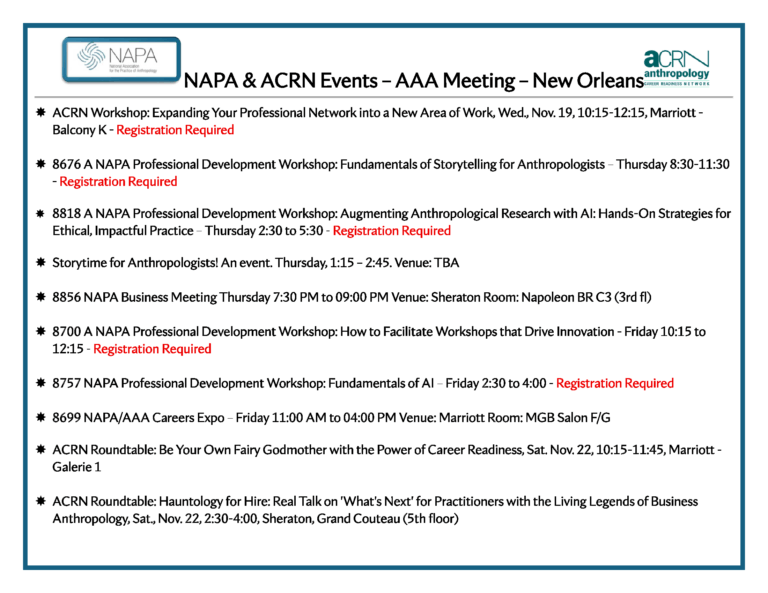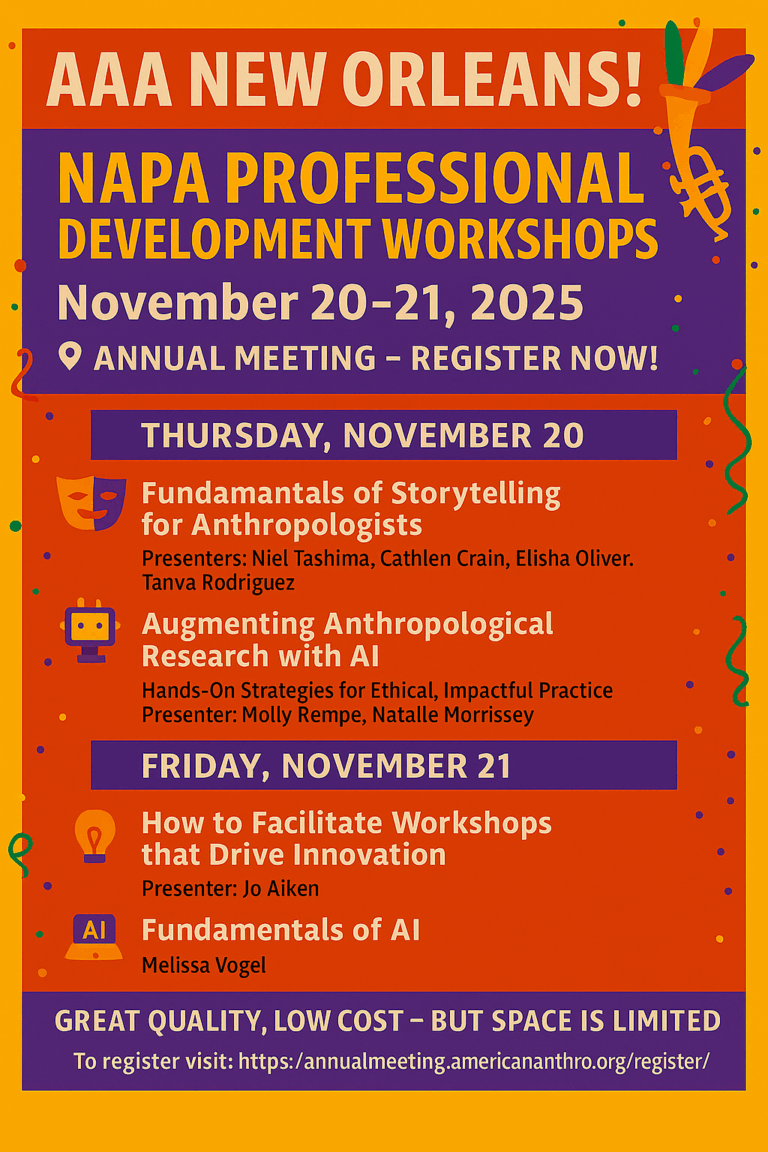National Association for the Practice of Anthropology
Breaking Down Silos in Anthropology: New Collaboration Models to Improve Integration between Academia and Practice
Many anthropologists recognize that there are silos within the discipline between practitioners and academics. At a Presidential Session at the 2019 AAA meetings, this topic and ways to break down the barriers were discussed. Session presentations are now available on a special archive page; review the videos and add your comments, thoughts, and ideas.
- Byadmin
- On
- 5 Comments
Overview and Purpose
At the 2019 AAA/CASCA meetings in Vancouver, a AAA Presidential Session explored siloing between academic and practitioner anthropologists, and how these silos can be bridged. (Session #3-0370; November 21, 2019)
The purpose of this page is to create an ongoing discussion on the topic of breaking down silos, which is important to the current and future vitality of our discipline. Please click on the respective links to review the video presentations, which are based on the session presentations, then add your own comments and ideas in the Discussion section below.
Panel Organizers
Mary Butler (U Maryland College Park) and Elizabeth Briody (Cultural Keys LLC)
Presenters
Daniel Ginsberg (AAA): The Past, Present and Future of Practitioners in the AAA
Suzanne Heurtin-Roberts (U Maryland College Park): Theory, Practice, and Knowledge, Oh My!
Mary Odell Butler (U Maryland College Park): De-Siloing Practice: Toward a More Visible Anthropology
Elizabeth K. Briody (Cultural Keys, LLC) and Robert J. Morais (Columbia Business School): Business Anthropology on the Road! Driving Practice onto Campus
Terry Redding (Independent consultant): Early Connections: Creating Space within Service to Engage Students and New Anthropologists
Sherylyn Briller (Purdue) and Zoe Nyssa (Purdue): A Space for Practice: Building Collaborative Networks of Learners and Practitioners
Discussant: Gillian Tett (Financial Times)
Bibliography
(Have you written about silos? If so, or if you have a reference to include, please let us know.)
Briody, E.K. and K.C. Erickson. 2017. “Success Despite the Silos: System-Wide Innovation and Collaboration,” In Maryann McCabe, ed., Collaborative Ethnography in Business Environments. London, UK: Taylor & Francis, pp. 26-59.
Ginsberg, D. 2019. “Anthropology Between Academia and Practice.” In Oxford Research Encyclopedia of Anthropology, edited by Mark Aldenderfer. Oxford University Press.
Tett, G. 2015. The Silo Effect: The Peril of Expertise and the Promise of Breaking Down Barriers. New York, NY: Simon & Schuster.
Discussion
Please note your thoughts and ideas on this topic in the space below. Some starting questions to address in the discussion forum:
• How do we continue to break down silos between academia and practice?
• When are these silos most noticeable between academia and practice ?
• What are the benefits of removing them, or at least building bridges between them?
Share your thoughts and ideas for moving the topic forward.




There are some important insights and recommendations here. “Silos” here seem to be of two different types: between non-academic practitioners and their academic cousins; and between anthropologists in general and other people out doing the world’s work. Elizabeth Briody is addressing the first of these through her roadshow with academic departments. Gillian Tett is clearly and persuasively framing the second.
But I think we are still in need of a clearer and more useful set of messages. We could, for example, spend less time on what are essentially academic debates about what “practice” is and who does it. We could – indeed, should – spend less time talking to ourselves about how incredibly useful anthropology is.
The messages that I think we need to start sending concern accomplishments – things that anthropologists (whether they call themselves practitioners or not) have actually done, alone or with others, to address social issues of the moment. Show, in other words; don’t just tell.
Anthropologists have done, and are doing, a lot, but not nearly as much as we could, or should. A lot of what we say we are doing seems to have no discernible effect on the world, whether you’re taking the long or short view of things. And quite a lot that we do that is successful and useful is not necessarily recognized as “anthropological.” So I think we have two clear and specific problems that we should be addressing.
The first is how to better train anthropologists to be more effective at working with others to create what Robert Chambers terms “good change.” The idea that anthropologists shouldn’t be associated with change is simply absurd.
The second problem is that of selling ourselves. Again, we’ve shied away from thinking of ourselves as needing to do this, but this attitude is partly responsible for our lack of influence, or even recognition, in the public sphere.
As a discipline, we need to find much better ways to highlight what we’re up to – not to NAPA or AAA members, but to the 99+ percent of humanity that doesn’t have an anthropology degree but struggles to get things done on a daily basis.
Many thanks for posting this panel and encouraging on-going dialogue. It deals with an important and timely subject. I would not have known about it otherwise, since I did not attend the 2019 AAA Convention.
I am one of the “hidden” anthropologists Mary Butler mentioned. I learned about anthropology as a teen in Middle school and obtained training and three degrees in social anthropology with the intention of applying my knowledge in practical ways. After seven unhappy years as an academic, I was lucky enough to be hired “off the street” overseas by USAID and spent 28 years as a “social analyst”, “agriculture officer”,”rural development officer”, and “program officer”. Thus I have some perspective on the intellectual and socio-cultural chasm between academic and applied anthropologists.
I think that the fundamental basis for the “silos” the panel explores is that the thrust of anthropological training rests on a “grant” world-view, while much if not most anthropological practice is a “market” world-view. The market view requires that activities, services (including research), and products (including analyses) be specified and delivered according to schedules related to client needs. The requirements are documented in the Terms of Reference of contracts between the client and the specialist. The grant approach assumes that a research topic is worthy in its own right. Support for the research stems from a patron who shares that belief and sees that its results have merit or benefit. Grant support allows the researcher to define objectives and methods, and allocate resources accordingly, with minimal input from the patron.
I found this difference in world-view most striking when, as a USAID program manager seeking research input for international development project design, I engaged anthropologists for specific enquiries at field sites. When I joined USAID after years as an academic researcher and teacher, I was employed as a Personal Service Contractor. I quickly found that my performance was strictly guided by the terms of my contract, as interpreted by my supervisor, and while my professionally-based input was appreciated, it was not given totally free rein. When I became a permanent, Direct-Hire USAID Foreign Service Officer, I not only designed and carried out research myself, but in my capacity as Mission Research and Evaluation Officer supervised local and expatriate social scientists’ research as well. I became increasing aware of and most often able to bridge the gap between differing world-views in my management role. However, I sometimes had to counsel, and even terminate employment of academy-based researchers who persisted in treating research specified by a contract as if it were a free-floating grant activity only marginally related to the contract Terms of Reference.
As the panelists note, one important element for training anthropologists for applied work is awareness of common business practice. This should include contract and grant requirements and differences. Most anthropology students learn about grants and their requirements, and that form of research support is by far the most common for academic research. The ability to draft clear and specific contract Terms of Reference, and to understand their requirements as a researcher, so far as I know, is not a part of an academic anthropological training curriculum. I learned the hard way. I hope we can incorporate this “market-based” element into applied anthropology curricula.
I look forward to others’ comments on this panel’s topic.
I value this online dissemination of the original small seating capacity on-site. In the playback of M.O. Butler it seems obvious, but applying ethnographic methods to the Practicing-vs-Campus anthropology is a natural project to sustain, year by year. For visual thinkers, it would be particularly helpful to be shown real-life instances of the proposed Silo-Bridging, both the effective AND the ineffective examples. By seeing what undertakings to seek after and what ones to avoid, the project can best move forward. In particular, what are some cases when classroom and research oriented colleagues integrate Practicing Anthro illustrations or problem sets? Complementarily, what are some cases when NAPA colleagues incorporate their fellow social scientist theories, comparative work, or documentary efforts? A gallery of real-life ebb and flow between the scholarly and the problem-oriented anthropologists would benefit colleagues in AAA and out, including among sister associations (World Council of Anthro Associations), and maybe even in the parallel worlds of allied social sciences: the interplay of practitioner & campus-based scholars in sociology, psychology, econ, and political science.
The 2019 AAA Presidential Session on collaboration between the academy and practice is inspiring. The opening presentations provide a good framework for understanding barriers and enticements for creating more collaboration, and the case study presentations make one wish for more.
I wonder how we can support practitioner/academic projects and publications. Speaking as someone who has had feet planted in both worlds, I yearn for greater media presence of anthropology’s contributions to dealing with social problems. How can we encourage practitioners, faculty and students to write about joint research projects — to increase awareness of anthropology’s participation in solving community and world problems — in academic journals, scholarly practice publications (e.g., NAPA, SfAA) and public media (newspapers, magazines, radio, websites)?
Can we develop a program to spur collaborative publishing (e.g., a program that advocates for such publications contributing to tenure for faculty and credits for students), or a prize that recognizes collaboration between academics and practitioners? The Session makes clear that anthropologists in the academy and in practice need one another to further our professional aims of theory, research and social change.
Maryann
I have only today seen your comments on the debate held at the 2019 AAA meetings. I was at the AAA last year but did not attend the NAPA meetings. How are you and Dave.
John Campbell
SOAS/London